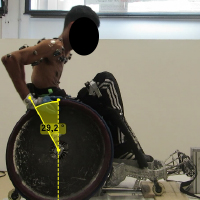Kinematic bidimensional analysis of the propulsion technique in wheelchair rugby athletes

Accepted: 3 March 2020
HTML: 11
All claims expressed in this article are solely those of the authors and do not necessarily represent those of their affiliated organizations, or those of the publisher, the editors and the reviewers. Any product that may be evaluated in this article or claim that may be made by its manufacturer is not guaranteed or endorsed by the publisher.
Authors
Wheelchair rugby is a sport ideated for individuals with cervical spinal cord injury (CSCI) which is extremely important for maintaining their neuromuscular abilities and improving their social and psychological wellbeing. However, due to the frequent changes in direction and speed it considerably stresses the players’ upper limbs. 13 athletes have undergone two sports-related tests on an inertial drum bench and several kinematic parameters have been registered. Most athletes use a semi-circular pattern which is considered protective for the upper limb. With increasing speed, range of motion (ROM) increases. Release angles increment and contact angles reduce, displacing the push angle forward to increase speed. Instead, the more anterior late push angle used to increase velocity is a factor which further loads the shoulder joint. However, other factors affecting propulsion technique, such as posture and wheelchair set up should be studied to further reduce loading on the upper limb.
How to Cite
PAGEPress has chosen to apply the Creative Commons Attribution NonCommercial 4.0 International License (CC BY-NC 4.0) to all manuscripts to be published.

 https://doi.org/10.4081/ejtm.2019.8902
https://doi.org/10.4081/ejtm.2019.8902



